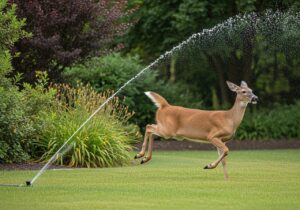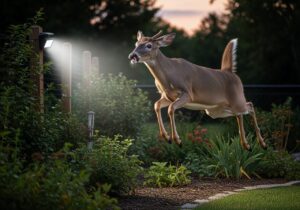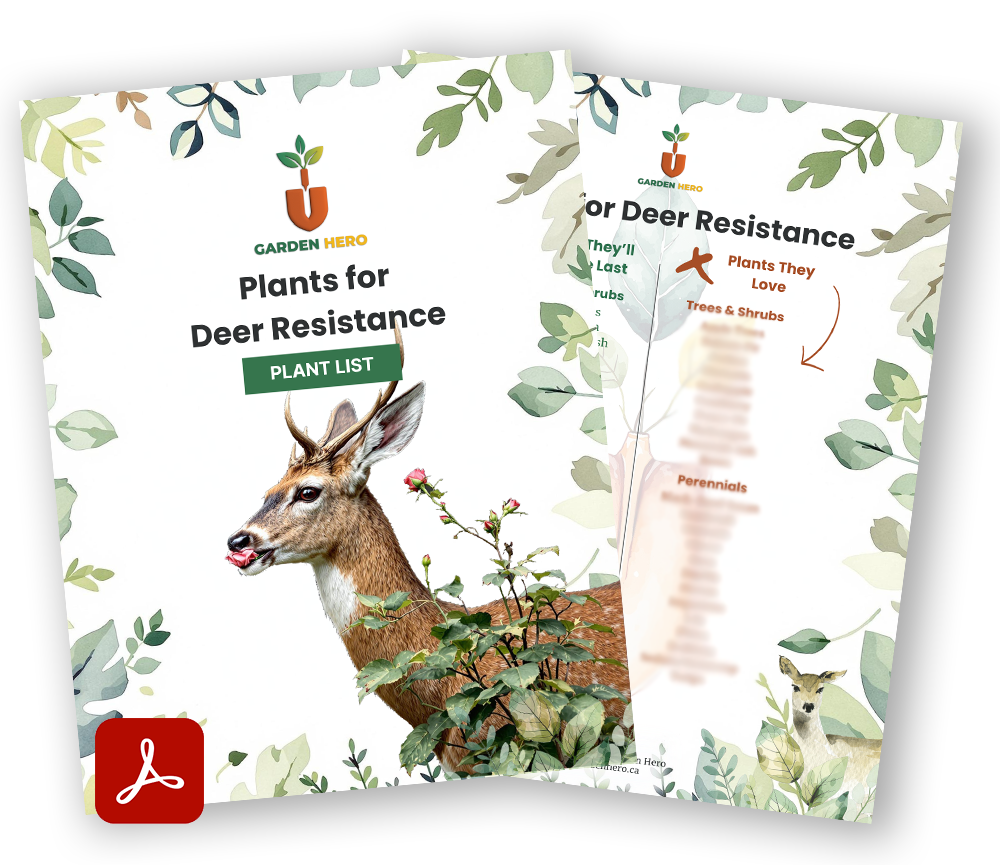If you’ve ever stepped outside to find your prized hostas nibbled down to nubs or your vegetable garden looking like a salad bar after closing time, you know the frustration of dealing with deer damage. While these graceful creatures are beautiful to observe from a distance, they can wreak havoc on carefully tended gardens. The good news? You don’t have to stand guard all night with a flashlight. Motion-sensor deer deterrents offer an effective, humane solution that works around the clock – even when you’re fast asleep.
How Motion-Activated Deterrents Work
Deer are skittish creatures by nature – sudden noises or movements can send them running. Gardeners can take advantage of this by using motion-activated deterrent devices that startle deer when they approach. Two of the most popular types are motion-triggered sprinklers and motion-activated lights or alarms:

Motion-Activated Sprinklers
These are sprinkler devices with an infrared motion sensor “eye.” When a large animal (like a deer) moves in front of the sensor, the device instantly shoots a sudden burst of water in that direction. The surprise of a cold spray is usually enough to scare the deer off. Products like the “ScareCrow” (deer sprinkler system) are commonly used for this purpose. They can be placed to guard a particular area (for instance, your vegetable patch or prize rose garden). These sprinklers react day or night (the infrared sensor detects warm-bodied animals even in darkness), giving 24/7 protection. Strategically placed, a motion sprinkler will make a deer think twice about entering that spot again after it’s been sprayed! Many gardeners find this method very effective, as it associates the garden with an unpleasant surprise. Just remember to shut off the device if you’re going to be in the garden – or you might get soaked by your own trap.

Motion-Activated Lights and Sounds
Another option is using devices like motion-activated floodlights or noise-makers. A sudden bright light flipping on can startle deer that sneak into your yard at night. Deer fear what they don’t understand, so an unexpected light often causes them to flee. Likewise, there are devices that emit a burst of ultrasonic sound or even a recorded predator growl when triggered. Even a low-tech approach – like hanging some bells or cans that rattle when a fishing line is tripped – can serve as a DIY alarm. The element of surprise is key. If deer begin to realize that a light or sound in a fixed location poses no real threat, they may eventually ignore it. Therefore, it can help to periodically move these deterrents around or change the pattern. For example, if you use a motion light, relocate it every week or two to a slightly different angle or area, so deer don’t get too accustomed to it in one spot. Some people even use a radio in the garden on a timer, playing talk radio or other music at night to give an impression humans are active nearby. This can work for a time, though crafty deer may learn that the humans never actually appear.

Want to create a complete deer-proof strategy?
Download our free Zone 2-4 Deer-Resistant Plant List to complement your motion deterrents with plants deer naturally avoid.
Why Motion-Activated Deterrents Are So Effective
The advantage of motion-based deterrents is that they only activate when needed, so deer aren’t continuously exposed to them (reducing the chance of habituation). As an automatic deer deterrent, they also keep your garden peaceful most of the time, only creating commotion when intruders arrive. When using these devices, it’s wise to combine them with other measures: for instance, use a sprinkler plus a repellent spray on plants for a one-two punch. Also, be mindful of aiming sprinklers away from walkways or windows, and check batteries or water hookups regularly. With proper setup, motion-activated deterrents can cover the gaps in your defenses – protecting those corners of your yard that fencing or sprays might miss, and training local deer that your garden is a place of unpleasant surprises.
Installation Tips for Success
Placement is Everything: Position your devices where deer typically enter your garden – look for worn paths, trampled areas, or gaps in existing barriers. Height matters too; mount sensors 2-3 feet off the ground to target deer-sized movement while avoiding false triggers from small animals.
Coverage Strategy: One device rarely covers an entire garden. Create overlapping zones of protection, especially around high-value plants. Remember, deer are creatures of habit – if you block their preferred route, they’ll often find another way in.
Seasonal Adjustments: Deer behavior changes with the seasons. Spring brings hungry mothers with fawns, summer means lush garden growth that’s irresistible, and fall triggers increased feeding before winter. Adjust your deterrent placement and sensitivity accordingly.

Want More Zone 2-4 Garden Resources?
Join our email list for resources on other common garden pests, and proven strategies that work in challenging Zone 2-4 conditions.
Maintenance Matters
Like any garden tool, motion-activated deterrents need regular attention. Check batteries monthly (cold weather drains them faster), clean sensors of spider webs or debris, and ensure water connections remain secure. For sprinkler systems, winterize properly in cold climates to prevent freeze damage.
The Bottom Line
Motion-activated deterrents aren’t a magic bullet, but they’re an excellent addition to your deer management toolkit. They work best as part of a comprehensive strategy that might include fencing, repellent sprays, and deer-resistant plantings. The key is persistence and adaptability – what works in spring might need tweaking by fall as deer learn and adapt.
Remember, the goal isn’t to harm these beautiful animals, but to redirect them to more appropriate dining locations (preferably not your garden!). With the right setup and maintenance, motion-activated deterrents can help you reclaim your garden while coexisting peacefully with your local deer population.
